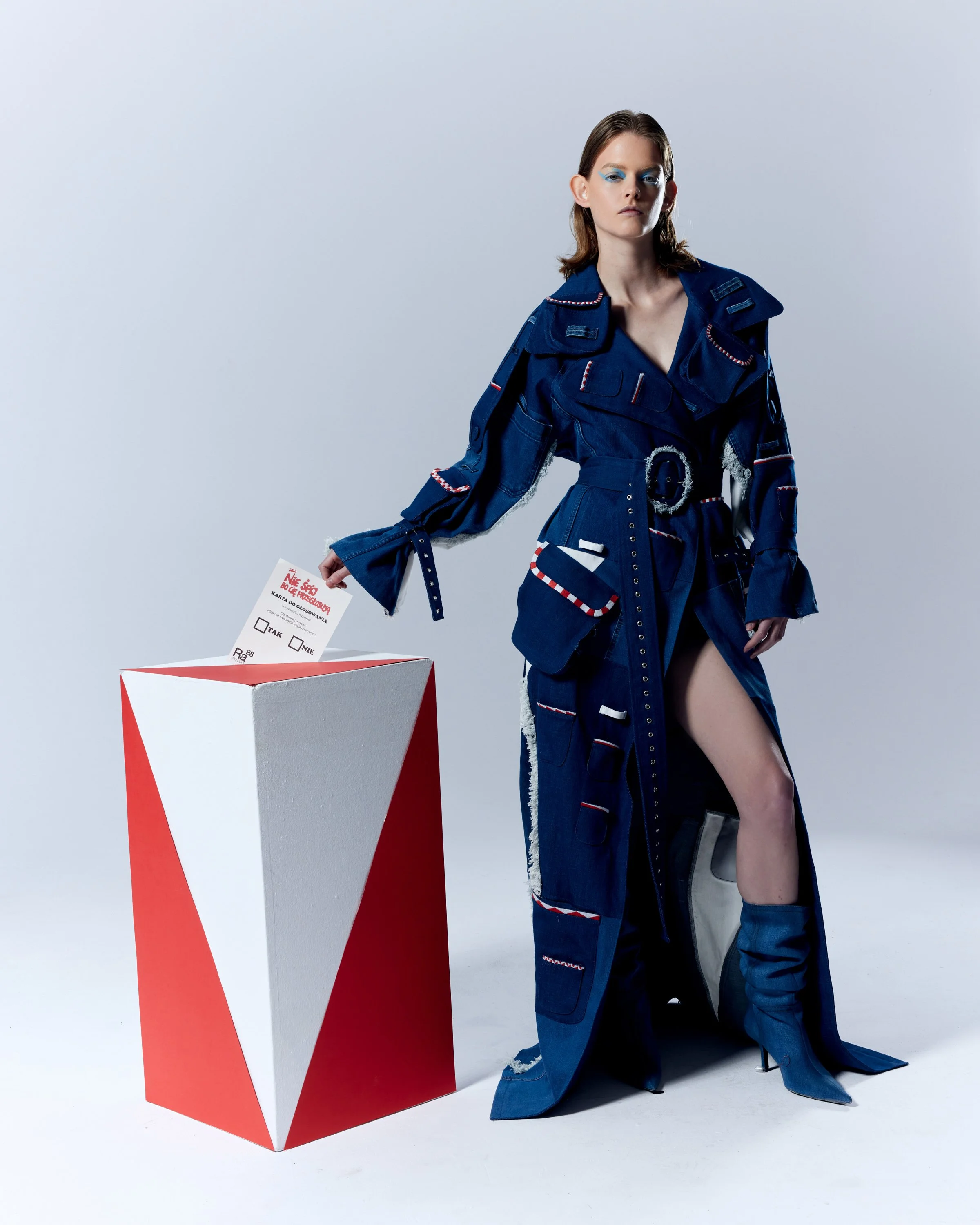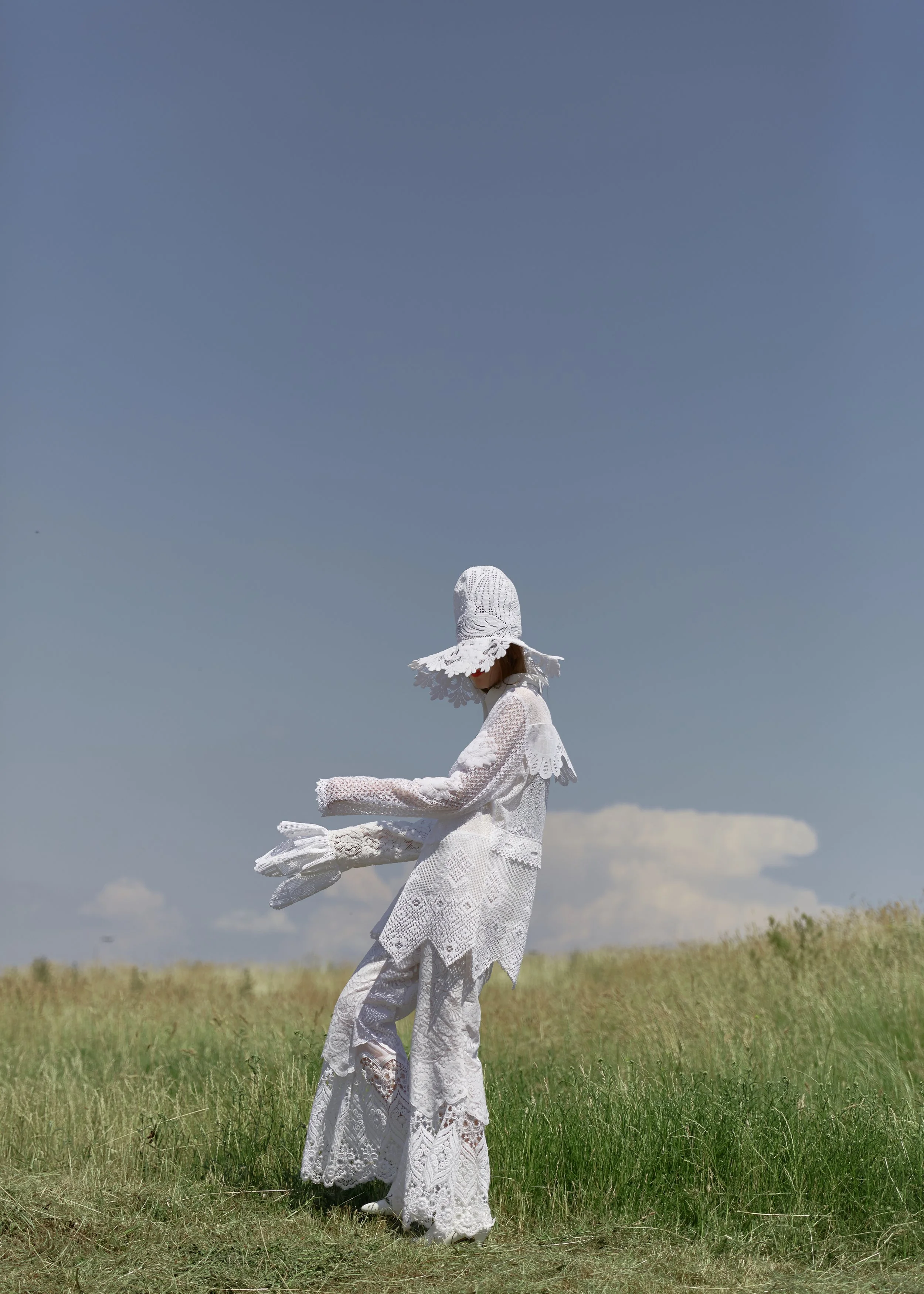RAD Duet - A Forward-Looking Ode to Craft
What it means to honour heritage - without getting stuck in nostalgia?
Juliusz Rusin and Maciej Jóźwicki; courtesy of designers
RAD is the design duo of Juliusz Rusin and Maciej Jóźwicki, both graduates of Poznań’s art schools. Since 2017 they bring together a poetic sensibility and a deeply considered, craft-led approach to contemporary womenswear.Their work explores Polish cultural identity and social transformation, bridging past and future through a dialogue between traditional and experimental techniques, unexpected material treatments, and a deep commitment to sustainability. Recycling, upcycling, and local production are fundamental principles in their work.
The name RAD is a nod to radium - the element discovered by their icon Maria Skłodowska-Curie. Curie is not their muse in the conventional sense however, but rather a symbol of intellect, dedication, and work ethic - qualities they deeply admire and strive to embody in their own creative practice.
Their projects go beyond fashion collections and include bespoke costumes for drag queens and celebrities, with recently, a long-cherished dream realised: dressing Alison Goldfrapp for her tour. They also maintain a long standing collaboration with Jazz & Silk Merino, a Poznań textile boutique where their immersive window installations have become a local fixture.
RAD was honoured with numerous awards so far, including the Design Alive Award in the Creator category for “skilfully engaging with Polish traditions and giving them a universal dimension.” Their pieces are often regarded as works of art rather than products and sold in auctions with some acquired by major institutions such as the Central Museum of Textiles in Łódź, as well as by private collectors around the world.
Wiesia collection; photo by Weronika Walijewska
Wiesia
Speaking with Maciej and Juliusz is inspiring. It’s immediately clear that RAD isn’t just a profession or creative project, it’s truly their whole life. They reflect openly on their journey, finish each other’s thoughts, and balance one another’s perspectives with ease. It’s a joy to witness that dynamic and passion. But this creative synergy didn’t appear overnight - it’s something they consciously shaped together. “In the beginning, we were still figuring each other out,” they recall with a smile. It was Wiesia - a Spring-Summer 2020 collection rooted in Polish folklore and childhood nostalgia, named in tribute to Maciej’s grandmother - that crystallised their common aesthetic. “That’s when we realised Polish culture, pop culture, and folk art were our true anchors. Since then, the collections almost shape themselves.”
For Wiesia, every material was upcycled. There were crochet bedspreads, lace curtains, vintage tablecloths, and family hand-me-downs all creatively transformed alongside Hutsul kilims and boldly patterned rugs from the 60s Yugoslavia. The collection also included references to Włocławek pottery, with its distinctive details and motifs translated into intricate hand-painted designs on faux leather. “Two of my aunts painted Włocławek pottery - one worked at the glazing station - and my grandfather was a mould-maker,” Maciej shares. “There’s a lineage I feel connected to.”
Wiesia collection; photo by Weronika Walijewska
photo by Weronika Walijewska
The collection’s lookbook and short film, created in collaboration with their long-standing creative partner Weronika Walijewska, beautifully illustrated the depth of their research, intention, and creativity behind each look. The set design played a key role in shaping the atmosphere of each shot. Cabbage fields, haystacks, Włocławek ceramics.. It all set the tone, grounding the collection in a uniquely Polish visual language.
photo by Weronika Walijewska
Nowadays, craft is everywhere in fashion, but more often than not, it’s reduced to a moodboard reference or a fleeting trend. What sets RAD apart is their deep sense of memory, sentiment and genuine respect for the topic. For them, craft isn’t just a reference but it’s a process. It’s structure, narrative and intention. Above all, it’s not about looking back, but about carrying tradition forward.
“Craftsmanship is something we absolutely glorify,” says Juliusz.“We try to integrate as much of it as possible, and to learn as much as we can. We don’t just want to be designers. We want to be great craftspeople too.” With every collection, they commit to learning a new technique or engaging with a new material, sometimes through research, sometimes by directly working with artisans. For one project, they spent time with the craftspeople at the Serpenta Association, learning the intricacies of basketry. “We didn’t commission the finished pieces,” they say. “We spent time with them, watched, asked questions. They shared their knowledge, and we took it from there. (...) Once you understand how something is made, you know how to bend it,” they explain. “And that’s when respectful reinterpretation becomes possible.”
photo by Weronika Walijewska
Process
At RAD, design begins with fabric. “Usually, we start with the material itself or the construction, it's a very tactile process” they explain. “We sample obsessively and those fragments of fabric get transformed in all kinds of ways.” Those tests help them ideate the shape and feeling of a piece before it’s even conceptualised in full. In turn sketching, if it happens at all, is fast and schematic “it’s more like a game of charades between us two.” says Juliusz laughing. “One of us draws something the other doesn’t quite understand, but then we start building it, and it ends up better than expected.”
While RAD’s practice is rooted in craft, it’s never simply about nostalgia. “We’re just as interested in emerging technologies as we are in traditional techniques,” they explain. Juliusz and Maciej are constantly looking ahead, engaging in ongoing dialogues with companies developing next-generation materials and experimental treatments in search of meaningful collaborations. "For us, it’s always about looking both to the past and the future, rather than following fleeting trends.”
Asked about music as a source of inspiration and whether it’s part of their creative process, Maciej admits, “I don’t actually listen to music while working.” He continues, “I prefer films playing quietly in the background. Often we’re immersed in different tasks, each orbiting in our own zones. Having familiar films on helps keep me grounded.” For Juliusz, it’s music “though I’m terribly mono-thematic,” he laughs. “Eighty percent of the time, it’s Goldfrapp. The rest? Mostly film scores, both Polish and international. Maybe some Róisín Murphy, Grace Jones… and a touch of Madonna when the mood calls for it.”
Sometimes however their moodboard extends to the soundtrack and cinema. For Wiesia, their playlist featured classics like Ewa Demarczyk, Wojciech Kilar, Irena Santor, and Zbigniew Wodecki on loop. On screen, it was Andrzej Wajda’s The Promised Land and Jerzy Antczak’s Nights and Days. Those references played a crucial role in shaping the atmosphere and tone of the collection.
Irena collection poster by Aleksander Walijewski
Storytelling
“When everything comes together the way we want, each look in the collection becomes an emotion or a character. That’s always our intention - for the collection to unfold as a series of stories, not just a sequence of aesthetics,” says Juliusz. “Our idea of coherence is different. For us, it’s about the concept,the narrative, rather than tied to a recurring visual motif or construction detail..”
A perfect example of their storytelling approach is the SS2023 collection, Irena. The name holds three layers of meaning. First, it honours two important Irenas from designers’ families - Juliusz’s grandmother and Maciej’s great-grandmother, both strong figures who lived through the communist era. Second, it draws from the Greek root of the name “Irene,” meaning “the one who brings peace.” Lastly, it references the Irena crystal factory in Inowrocław, which operated for nearly a century before closing just before the coronavirus pandemic.





Moreover, the collection is conceptually divided into five sections: worker, revolution, propaganda, everyday, and illusion. A lot of inspiration were drawn from the films of Andrzej Wajda such as Man of Marble, Man of Iron, and Hunting Flies. These themes are translated into wearables through intelligent material choices and intricate techniques and reinventions. One of the standout pieces is a beige gown, entirely covered in hand-sewn crystal casts. All crystal elements were designed, 3D-printed, and finished by the designers themselves. A true haute couture piece. Witness the process on the video below.
Their following collection, Maria, is dedicated to their patron Maria Skłodowska-Curie, and is also rich in metaphorical layers and embedded narratives.. Each silhouette represents a different stage of her life or a particular chemical element which is translated into silhouettes and textile treatments. “In Chlorine, we dyed denim and then bleached it to create an organic, blue-green pattern. The look is finished with accessories made from recycled lace that glows in the dark thanks to luminescence,” they explain. One standout piece is a coat crafted from two vintage double-weave wool throws, giving traditional textiles a strikingly futuristic feel.“The toxic green wool against the black background immediately reminded us of radium and its radioactive glow,” they add.
double weave coat from Maria collection by Rad Duet
Both Juliusz and Maciej believe that garments can carry hidden power, that they can act as talismans or reminders of particular moments and emotions. “What matters most to me is that clothes have meaning,” says Maciej, explaining how this belief influences all their fashion choices. “I won’t buy something unless there’s a story behind it. I’d rather find something second-hand - on Vinted, for example - if someone can tell me who wore it, where it came from, what it meant. I don’t want clothes to be soulless objects.”
Alison Goldfrapp by RAD Duet
Future
While Juliusz and Maciej are incredibly productive, their process is never rushed. The duo doesn’t follow the established fashion calendar, and some collections take years to fully materialise. “We’re quite different in how we plan,” says Juliusz. “I’m the kind of person who needs lists and mind maps just to stay grounded, otherwise I get completely lost. But mostly, we just talk through where we’re headed, what we’d love to achieve. It’s not so much about deadlines, but direction.”
They’re also not afraid to dream beyond their current means. Whether imagining shows that rely on yet-to-be-invented technologies or designs that feel just out of reach yet - they welcome all bold ideas. “We actually mantra that to ourselves,” admits Maciej. “We’re not afraid of dreaming—and we’re not afraid to speak those dreams out loud, even the most abstract ones. It’s those visions that keep pushing us forward. (...) When your brand is your livelihood, your passion, and your biggest dream all at once, those visions become your fuel. They’re more powerful than any external obstacle.”








